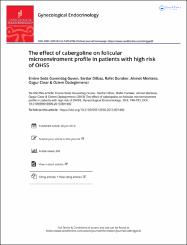The effect of cabergoline on folicular microenviroment profile in patients with high risk of OHSS

Göster/
Erişim
info:eu-repo/semantics/closedAccessTarih
2013Yazar
Güven, Emine Seda GüvendağDilbaz, Serdar
Duraker, Rafet
Menteşe, Ahmet
Çınar, Özgür
Özdeğirmenci, Özlem
Üst veri
Tüm öğe kaydını gösterKünye
Guven, E.S.G., Dilbaz, S., Duraker, R., Mentese, A., Cinar, O., Ozdegirmenci, O. (2013). The effect of cabergoline on folicular microenviroment profile in patients with high risk of OHSS. Gynecological Endocrinology, 29(8), 749-753. https://doi.org/10.3109/09513590.2013.801440Özet
The aim of this study to evaluate the effect of cabergoline on follicular microenvironment by measuring follicular fluid (FF) insulin like growth hormone -I (IGF-I), antimullerian hormone (AMH), inhibin B and hepatocyte growth factor (HGF) levels in women with PCOS and high risk of ovarian hyperstimulation syndrome (OHSS). in this prospective cohort study, 41 women with PCOS undergoing controlled ovarian hyperstimulation for assisted reproduction and having the high risk factors for OHSS are included. the women in the study group (n = 15) received cabergoline for OHSS prevention while the women in the control did not received any medications for OHSS prevention. FF samples were collected during oocyte pick-up procedure for all women were determined using commercially available ELISA kits. Concentrations of FF IGF-I, AMH, inhibin B and HGF were assessed. in the study group FF AMH (2.96 +/- 1.27 versus 1.91 +/- 0.64 ng/mL), Inhibin B (1339.47 +/- 198.56 versus 1200.09 +/- 133.64 pg/mL), HGF (5623.21 +/- 2411.09 versus 3787.42 +/- 2269.89 pg/mL) and IGF-I (298.60 +/- 37.80 versus 219.90 +/- 71.40 pg/mL) concentrations were significantly decreased compared with control group. Cabergolin prevents OHSS in high risk patients by disrupting FF hormone microenvironment.

















